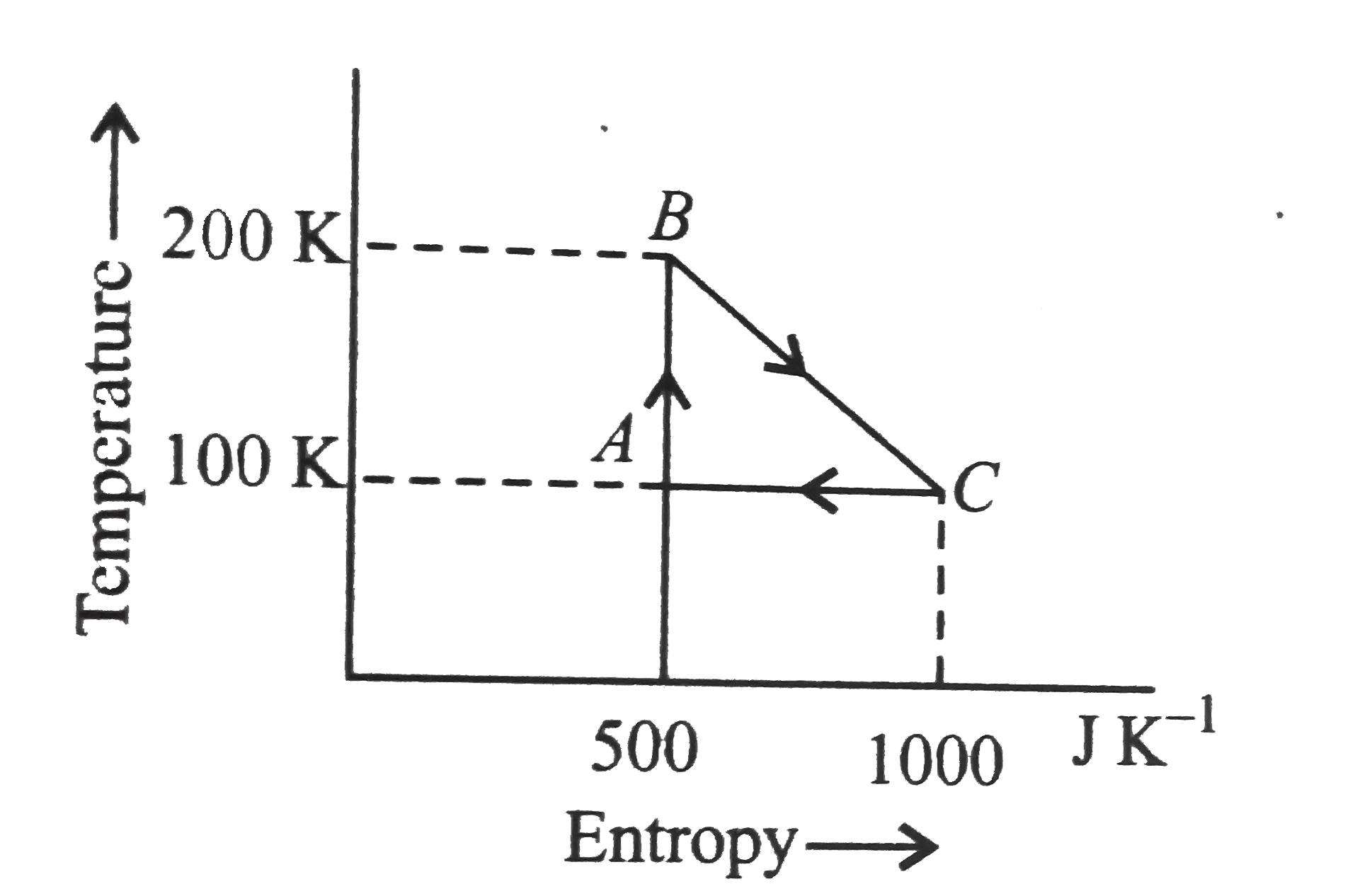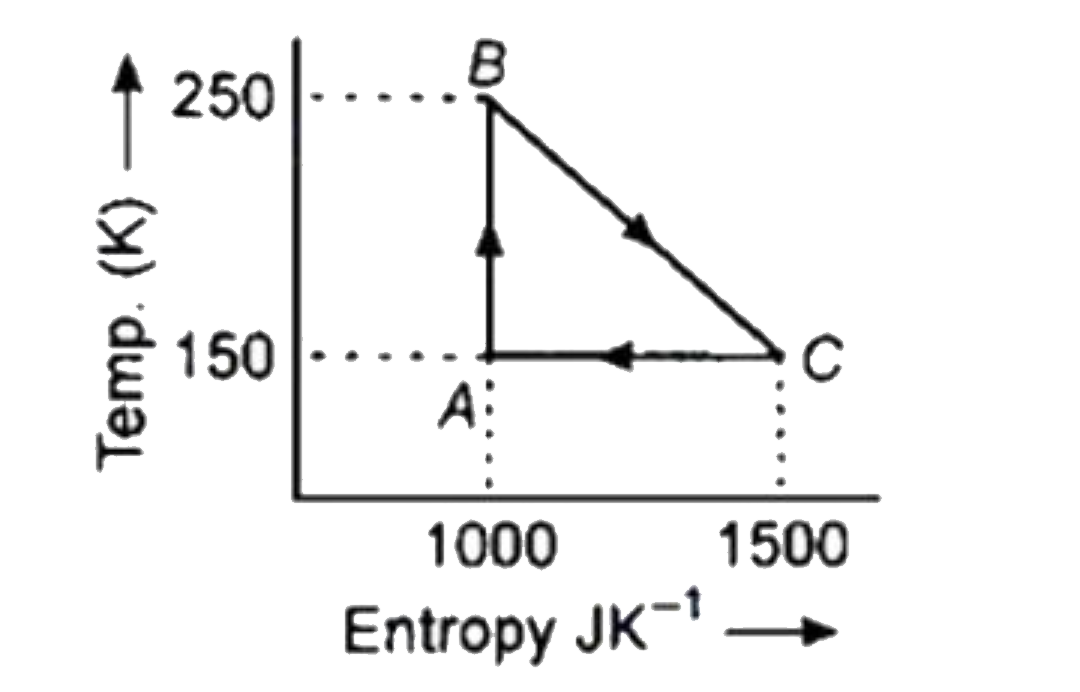What is meant by reversible engine? Explain, why the efficiency of a reversible engine is maximum.
The correct Answer is:The engine, in which the process can be retraced at any stage of its operation by reversing the boundary conditions, is called a reversible heat engine. Its efficiency is maximum, as no dissipation of energy takes place against friction, etc in such a heat engine.
Step-by-Step Solution:
1. Definition of an Engine:
An engine is a device that converts heat energy into work. In this process, heat serves as the input, and work is the output.
Hint: Remember that the core function of an engine is to transform energy from one form to another.
2. Cyclic Process:
An engine operates in a cyclic manner, meaning it goes through a series of processes that eventually return to the initial state. This allows the engine to continuously convert heat into work.
Hint: Think of a cycle as a loop where the starting and ending points are the same.
3. Reversible Engine:
A reversible engine is one that can operate in both forward and reverse directions. This means that the engine can retrace its steps precisely without any loss of energy. For example, if the engine moves from state A to state B, it can return from state B to state A following the same path.
Hint: Focus on the concept of retracing steps and the ability to reverse processes without energy loss.
4. Boundary Conditions:
The reversibility of an engine is achieved by reversing the boundary conditions of the system. This means that the engine can adjust its operation based on the external conditions to maintain reversibility.
Hint: Consider how changing the environment or conditions can affect the operation of the engine.
5. Efficiency of Reversible Engines:
The efficiency of an engine is defined as the ratio of the work output to the heat input. For reversible engines, particularly the Carnot engine, it is assumed that there is no friction or other forms of energy loss. This absence of friction leads to minimal heat loss, maximizing the efficiency of the engine.
Hint: Recall that efficiency is all about minimizing losses; the less heat lost, the more efficient the engine.
6. Carnot Engine:
The Carnot engine is a theoretical model of a reversible engine that operates between two heat reservoirs. It is considered the most efficient engine possible because it operates under ideal conditions (no friction, no energy loss).
Hint: Think of the Carnot engine as the benchmark for efficiency in thermodynamic systems.
7. Conclusion:
Therefore, the efficiency of a reversible engine is maximum because it minimizes energy losses, particularly heat losses, during the conversion of heat into work. This is why reversible engines, like the Carnot engine, are considered ideal.
Hint: Summarize the key points: no energy loss = maximum efficiency.
An engine is a device that converts heat energy into work. In this process, heat serves as the input, and work is the output.
An engine operates in a cyclic manner, meaning it goes through a series of processes that eventually return to the initial state. This allows the engine to continuously convert heat into work.
A reversible engine is one that can operate in both forward and reverse directions. This means that the engine can retrace its steps precisely without any loss of energy. For example, if the engine moves from state A to state B, it can return from state B to state A following the same path.
The reversibility of an engine is achieved by reversing the boundary conditions of the system. This means that the engine can adjust its operation based on the external conditions to maintain reversibility.
The efficiency of an engine is defined as the ratio of the work output to the heat input. For reversible engines, particularly the Carnot engine, it is assumed that there is no friction or other forms of energy loss. This absence of friction leads to minimal heat loss, maximizing the efficiency of the engine.
The Carnot engine is a theoretical model of a reversible engine that operates between two heat reservoirs. It is considered the most efficient engine possible because it operates under ideal conditions (no friction, no energy loss).
Therefore, the efficiency of a reversible engine is maximum because it minimizes energy losses, particularly heat losses, during the conversion of heat into work. This is why reversible engines, like the Carnot engine, are considered ideal.
Topper's Solved these Questions
- KTG & THERMODYNAMICSBOOK - RESONANCE ENGLISHCHAPTER - KTG & THERMODYNAMICSEXERCISE - Exercise-2
1 Videos
- KTG & THERMODYNAMICSBOOK - RESONANCE ENGLISHCHAPTER - KTG & THERMODYNAMICSEXERCISE - PART -I
15 Videos
- KTG & THERMODYNAMICSBOOK - RESONANCE ENGLISHCHAPTER - KTG & THERMODYNAMICSEXERCISE - PART -II
17 Videos
- KINETIC THEORY OF GASES AND THERMODYNAMICSBOOK - RESONANCE ENGLISHCHAPTER - KINETIC THEORY OF GASES AND THERMODYNAMICSEXERCISE - Exercise
64 Videos
- MAGNETIC FIELD AND FORCESBOOK - RESONANCE ENGLISHCHAPTER - MAGNETIC FIELD AND FORCESEXERCISE - Exercise
64 Videos
Similar Questions
What is meant by reverse osmosis?.
View SolutionThe efficiency of carnot engine depends on
View SolutionWhat is true of reverse genetics
View SolutionAssertion : The efficiency of a heat engine can never be unity.
Reason : Efficiency of heat engine is fundamental limitation given by first law of thermodynamics.
View SolutionThe maxium possible efficiency of a heat engine is
View SolutionThe efficiency of a heat engine is defined as the ratio of the mechanical work done by the engine in one cycle to the heat absorbed from the high temperature source . η=WQ1=Q1−Q2Q1 Cornot devised an ideal engine which is based on a reversible cycle of four operations in succession: isothermal expansion , adiabatic expansion. isothermal compression and adiabatic compression.
_E01_238_Q01.png)
For carnot cycle Q1T1=Q2T2. Thus η=Q1−Q2Q1=T1−T2T1 According to carnot theorem "No irreversible engine can have efficiency greater than carnot reversible engine working between same hot and cold reservoirs"._E01_238_Q02.png)
Efficiency of a carnot's cycle change from 16 to 13 when source temperature is raised by 100K. The temperature of the sink is-
View SolutionThe efficiency of a heat engine is defined as the ratio of the mechanical work done by the engine in one cycle to the heat absorbed from the high temperature source . η=WQ1=Q1−Q2Q1 Cornot devised an ideal engine which is based on a reversible cycle of four operations in succession: isothermal expansion , adiabatic expansion. isothermal compression and adiabatic compression.
_E01_236_Q01.png)
For carnot cycle Q1T1=Q2T2. Thus η=Q1−Q2Q1=T1−T2T1 According to carnot theorem "No irreversible engine can have efficiency greater than carnot reversible engine working between same hot and cold reservoirs"._E01_236_Q02.png)
A carnot engine whose low temperature reservoir is at 7∘C has an efficiency of 50%. It is desired to increase the efficiency to 70%. By how many degrees should the temperature of the high temperature reservoir be increased?
View SolutionThe effiency of reversible engine is___the irreversible engine.
View SolutionThe efficiency of the reversible cycle shown in the given figure is

View SolutionThe efficiency of the reversible cycle shown in the figure will be

View Solution
